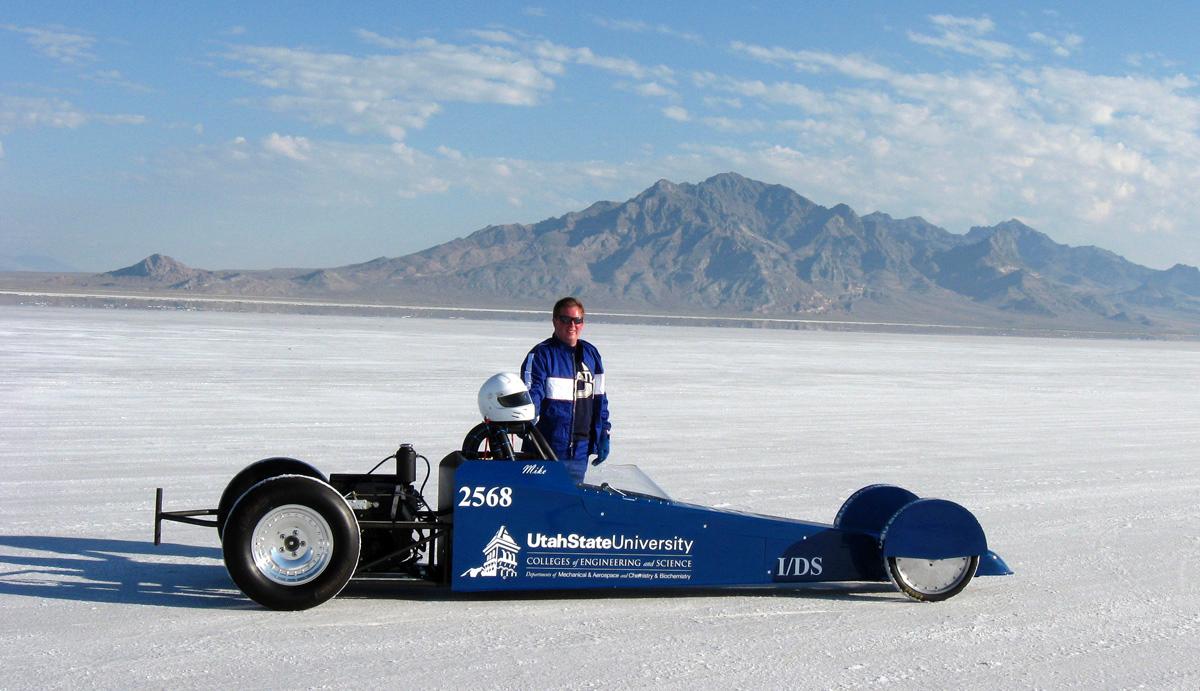Biofuel car sets a land speed record
A collaboration from the Colleges of Engineering, Science and Agriculture rolled out onto the Bonneville Salt Flats earlier this month.
An Aggie-blue biofuel streamliner set the land speed record in the small-engine class petroleum-fuel diesel streamliner division in the World of Speed event held at the flats on Sept. 10. The car’s top speed was marked at 64.4 mph.
The car ran off of a special biofuel made from yeast. The project started six years ago, when the colleges came together and decided to tackle an alternative fuel source to help the transportation sector get away from foreign oil, according to Lance Seefeldt, a professor in the biochemistry department.
“We discovered the fuel behaved beautifully,” Seefeldt said. “There really are superior fuels that are as good as fuel that you would get at the pump.”
Seefeldt said the team went to the flats hoping they could learn how to improve the car they had finished building only two days before. The car passed the safety inspection and they were able to run it on the speedway.
Around six months ago, the team developed a biofuel they could produce regularly on
a large scale. Alex McCurdy, a third-year graduate student, has been working to develop the biofuels. McCurdy produced a fuel that could be produced quickly, Seedfeldt said.
Seefeldt said the biofuel is amazing because it leaves a lower carbon footprint than diesel from the pump.
“The emissions are so much cleaner than regular diesel fuel,” he said. “It’s just really impressive. The more important feature is that it is renewable. We can make it here at home from waste material that we already have.”
To make the fuel, the team took leftover waste from cheese production and fed it to yeast. The yeast produces a simplified molecule used in the chemistry to create biofuel, McCurdy said.
“We take a waste product that’s cheap, basically free, and turn it to biofuel,” he said.
Although they weren’t aa used this year, McCurdy said his team has created three different biofuels in the lab.
“One is made from bacteria, one made from yeast and one made from algae. It just happened we could produce yeast more proficiently in a larger quantity,” he said.
McCurdy said the scaled-up production was about 1000 times more than the first small vial of fuel they were able to make.
“It was a lot of years and a lot of research and that wasn’t all that long ago,” said Mike Morgan, the driver of the streamliner and a senior majoring in biochemistry. “I remember the first vial and how excited everyone was.”
Seedfeldt said they were surprised about how much attention they got when they lined
up with the other cars.
“Our car had a consistent crowd around it,” he said. “I didn’t see any other cars that had a consistent crowd around it.”
Seefleldt said people were also surprised how little money they had spent on making the car.
“This car project was done on a shoestring,” he said. “We’ve all donated time, because it’s our passion.”
The car was unique in design because it was custom-made and because the diesel-generator engine and transmission were visible from the back, according to Morgan.
“They announced over the PA that it smelled like someone was baking bread,” Morgan said. “The fuel made out of yeast has a really distinct smell.”
Seefeldt said next year the team wants to go back to the salt flats and do some more passes with algae, yeast and bacteria.
McCurdy said they will definitely be able to run the car with biofuel from algae in the near future.
Seefeldt said the separate teams are working to achieve common goals.
“There are two teams of engineers working on car upgrades, specifically the aerodynamics and
transmission,” Morgan said.
Seefeldt said as the team further develops the streamliner, they want to continue using fuels that may feasibly be produced commercially.
“Our goal right now is just to go faster,” He said. “We want to push the envelope and break 100 miles per hour.”
Seedfeldt said the key to the project was the combined efforts of the three departments.
“Collaboration is what drives us,” he said. “The biggest feat of this venture is that fact that we’re working together. You don’t see that in the world today.”
Morgan said their collaboration efforts are now expanding to outside companies who want to bea part of this effort to create alternative fuel sources.
“We are going to be on the frontlines,” he said.
– katrimw@gmail.com

